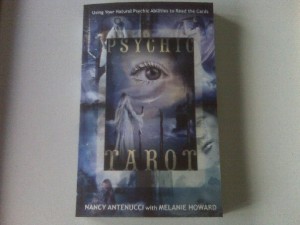 The first Readers Studio I ever attended was in 2009. It was there I met Nancy Antenucci. She is a lovely woman with warm, friendly energy and an easy sense of humor. This comes across in her book, Psychic Tarot. Her approach to tarot reading and psychic ability is playfully serious and real. There’s been a tendency, in many of the books I’ve read, to treat the subject of tarot reading too solemnly. It’s refreshing to dive into a book that embraces the mundanity and spirituality of tarot in a matter-of-fact way while embracing the true meaning of divination. Tarot is a wonderful tool for accessing your higher self and finding the divine guidance that speaks through your intuition. This book helps you do both of those things.
The first Readers Studio I ever attended was in 2009. It was there I met Nancy Antenucci. She is a lovely woman with warm, friendly energy and an easy sense of humor. This comes across in her book, Psychic Tarot. Her approach to tarot reading and psychic ability is playfully serious and real. There’s been a tendency, in many of the books I’ve read, to treat the subject of tarot reading too solemnly. It’s refreshing to dive into a book that embraces the mundanity and spirituality of tarot in a matter-of-fact way while embracing the true meaning of divination. Tarot is a wonderful tool for accessing your higher self and finding the divine guidance that speaks through your intuition. This book helps you do both of those things.
Through creative lessons and innovative activities the authors lead you back to trusting yourself. They meet you where you are and help you strengthen the abilities you presently possess. The friendly introduction segues into dealing with the biggest problem most people have with this topic: Blocks. Unlike most tarot books that give you set meanings for the cards, in the next few chapters you are instead introduced to the cards and encouraged to build your own relationship with and understanding of each one. This approach works especially well with the Court Cards, a section of the tarot that can be quite vexing. If that were all this book offered it would be worth the cover price. But wait! There’s more.
Following your dance with the cards there are a few chapters dealing directly with honing and enhancing the psychic ability we all have. With some clever exercises you will discover what you can already do and how to build on it. The next six chapters each address one principle. The Six Priciples together form a wonderful working system applicable to any form of divination. Then all the skills taught in the book are brought together in a chapter on reading tarot with varying degrees of the Sight. This is a wonderful demonstration of how it goes in real life practice. Chapter Nineteen is a brilliant addition. It is called “Helpful Boundaries” and explains exactly what that is. As a reader you interact with people on a different level. This chapter helps you draw the lines separating what is and is not acceptable. Learning and employing healthy boundaries keeps you safe, comfortable and helps you navigate situations as they arise. The appendices are quite handy. Appendix A is an entire deck of tarot cards in miniature and Appendix B is a Self-Study Guide.
This book is long overdue. Tarot reading is wandering away from its divination roots and becoming too much about psychology. While that viewpoint does have its place a balance needs to be struck. This book is a giant step toward that balance.